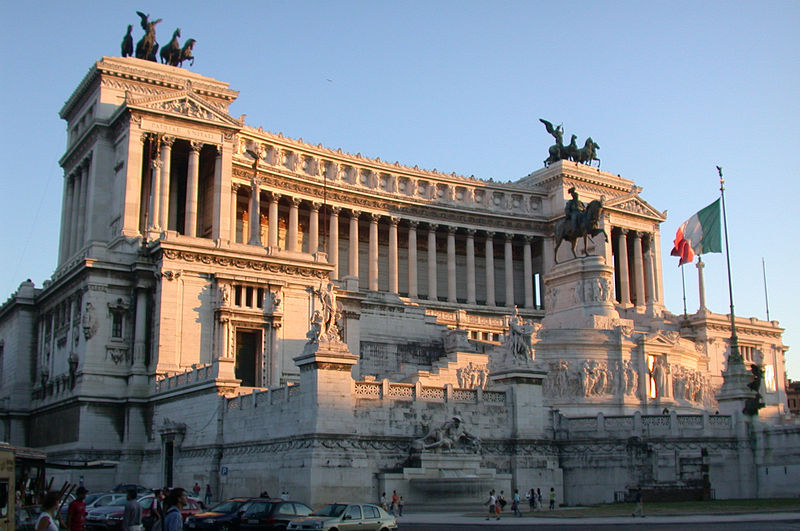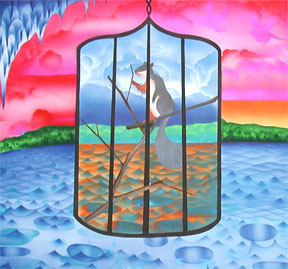
I'm living in Rome now, not too far away from this thing, the monument to Victorio Emmanuel II. It was designed by Guiseppe Sacconi and although it was started in 1911, it wasn't finished until 1935, and which point Sacconi, thank God, was dead. Sacconi might have been aware of the controversy about the site of the monument- it was built over medieval remains, displaced a bunch of people and cut into the hill in an ugly way- but my hope is that he died before the monument itself became a legend. Because while all that sucked, it sucked in 1935. Mussolini made speeches on it in the following decade, but that's not what anyone's talking about, and even that was 64 years ago. And nobody's moving on.
Every text about this monument says some version of the same thing. From Wikipedia:
The monument itself is often regarded as pompous and too large. It is clearly visible to most of the city of Rome despite being boxy in general shape and lacking a dome or a tower. The monument is also glaringly white, making it highly conspicuous amidst the generally brownish buildings surrounding it, and its stacked, crowded nature has lent it several derogatory nicknames. Romans sometimes refer to the structure by a variety of irreverent slang expressions, such as "Zuppa Inglese", "the wedding cake", and "the false teeth", while Americans liberating Rome in 1944 labeled it "the typewriter", a nickname also adopted by the locals.
My Blue Guide to Rome can't get enough of how hideous this monument is, and neither can the Eyewitness guide. Lonely Planet even gets in on the action. Rick Steeves, Mr. Nice, says," From its roof you see everything in town, except this pompous, oversized monument — nicknamed "the typewriter" and "the wedding cake."
I've yet to find my eyeballs bursting in to flame when I see it. I pass it on the way to and from work, and today I took the trouble to climb it. I was looking for the ugly.
I didn't find it. I left the monument as mystified as I was when I got there. There are beautiful views from the top. There are some goofy sculptures, but there are good ones too. It's not ugly.
One of my students pointed out that it's gaudy, but lots of things in Rome are gaudy. Such as this:

St.Peters is also big, white, ornate and morally dubious. And Pope Ratzinger makes speeches in it. Ratzinger, whatever else he may be, is a walking incitement to nickname.
The whole thing reminds me of the way that when I was in high school there seemed to be collective decisions made about people's attractiveness that had little do with how people actually looked. One of the most beautiful women I've ever known was considered ugly in my high school, and another fairly plain girl had dates lining up around the block. She was nice, but this was a long line, and these were not deep sweet boys looking into the depths of her soul. It was just that agreements had been made. Nancy was pretty. Rebecca was not. You didn't need to use your actual eyes if you knew that by professing affection for Nancy you were not going to have to argue your point.There was a certain cowardice about it, but it wasn't malicious: liking Nancy, as hating the Monument to Vittorio Emmanuel II, was a symbolic nod to the collective. It was a bow to public opinion and ease. Plus Nancy was nice.
But calling Vittorio Emmanuel II's monument ugly is really reaching. This is ugly.

There is a lot of ugly. But there's not that much ugly that has a nickname, or that is made of sparkly clean marble and offers stunning views of a city.
The gaudy to ugly connection strikes me as the heart of the matter. There's a smugness inherent in the word gaudy. Gaudy is trying too hard, unrestrained, unsophisticated, over the top. It's wearing all its accessories at once, flashing at you with open need, appealing to everyone indisciminately. It's the opposite of minimal. It's not modern. It's not sophisticated. It's out there, wanting you to like it.
And what's wrong with that? We're not talking about people, we're talking about architecture. Shouldn't architecture try as hard as it can? Shouldn't it give you as many reasons as possible to like it, and to relate to it on a human scale? Shouldn't it flash its ornamentation at everyone?
Another of my favorite buildings, the Philadelphia city hall, is also nicknamed the wedding cake. (Apparently we don't like our architecture with icing.)

Both buildings are full of allegorical statues; The monument to Vittorio Emmanuel II has statues personifying the cities of Italy on it, and Philly's city hall is a cake full of Industry, Patience and Honor. We don't think that way any more, but it might be helpful to do so in this case. Imagine the Monument to Vittorio Emmanuel as a Gaudiness personfied. Imagine that as a statue. Of someone gaudy. Dolly Parton? Imagine Gaudy's opposite. It's much harder to come up with a visual of that statue- who would it look like? Someone so minimal, so sophisticated, so absolutely not trying too hard that they personify restraint and culture...John Malkovitch?
Who would you rather have dinner with? Well, fine, but who would you rather have attend your sister's wedding? The one where all your rotten cousins show up and get obnoxious, and your dad drinks too much champagne and your mom sings that awful song for the five hundredth time...The personification of minimalism is really great for impressing a small party of sophisticates, but you've got to go with Gaudy for good manners and pleasing a crowd. And doesn't civic architecture, which is, after all, about public space, have an obligation to try to be pleasing?
I'm not suggesting that we should return to the Baroque or that minimalism is bad. I love me some great minimalist architecture. But let's stop trying to impress John Malkovitch by dissing the monument to Vittorio Emmanuel II. It only wants us to love it. And we might as well.

No comments:
Post a Comment